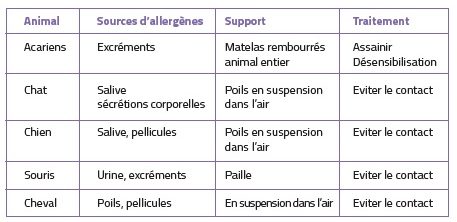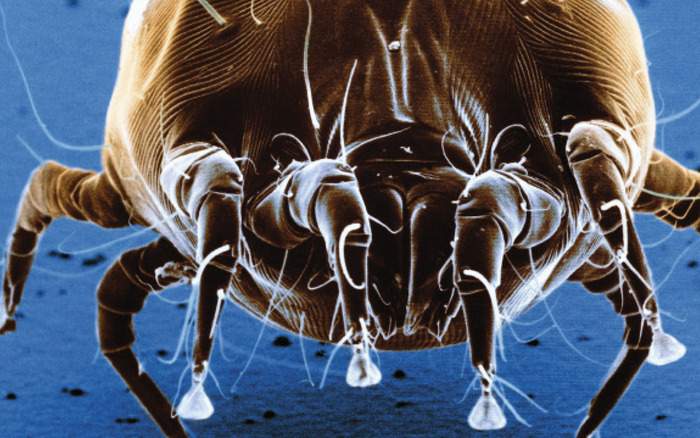ALLERGIES TO HOUSE DUST AND PETS? WHAT ARE THEY?
In addition to pollen, dust mite proteins, like proteins from feathered and furry animals (e.g. cats, dogs and horses), are the main cause of allergic reactions and diseases such as asthma, rhinitis (i.e. sneezing attacks, blocked nose, etc.) and conjunctivitis (inflammation of the conjunctiva).
In Switzerland, almost one in ten people have a positive skin test for dust mites and about 80% of children with year-round asthma are sensitized to dust mites. Today, dust mite allergy has become the leading cause of chronic allergic asthma in Europe. In our country, 1.72 million cats and 503,000 dogs have been registered (Federal Statistical Office, 2020). Due to their small size, animal allergens are the cause of asthma in the majority of cases. This is especially true for cat and dog allergens, whose particles are so small that they can float in the air for hours. This explains why an allergic person may feel uncomfortable as soon as they enter a house, even if they don’t know that a dog or cat lives there.
ALLERGIES TO HOUSE DUST AND ANIMALS: WHAT HAPPENS?
What is a mite?
Dust mites are small arachnids that live in warm and humid places. They have a predilection for our mattresses, pillows, blankets, carpets and upholstered furniture. They multiply at different rates depending on environmental conditions (temperature, relative humidity). These mites feed on dead skin flakes and produce up to 40 balls of excrement per day. These contain the enzymes that are held responsible for the allergy: the allergens. Even dead animals, which dry out and decompose into dust, are a major source of allergens.
Where do animal allergens come from?
Allergens (the substances that cause allergy) are the protein components in the saliva, sweat, sebum or urine of animals and are partly under hormonal control. As a result, sterilized animals are better tolerated. These allergens adhere to the animal’s hair or feathers, spread in the environment and are inhaled. They thus come into contact with the mucous membranes of the nose and bronchi.
How do I recognise an allergy?
The onset of an allergic reaction to dust mites or animals often goes unnoticed: a blocked nose in the morning is not very spectacular. This gradual onset is typical of an allergy that becomes chronic. As with hay fever, it all starts with sensitisation to the substance that triggers the allergy. Specific antibodies (protein molecules designed to fight pathogens and other foreign substances) are formed in the body. Only the new contact with the allergen then leads to an allergic reaction, which manifests itself as itching, runny nose and attacks of acute respiratory distress.
If pets stay indoors, such as house cats, hypersensitive people immediately show corresponding symptoms such as sneezing or shortness of breath. As our pets often live permanently in our homes, allergic symptoms usually occur throughout the year.


HOUSE DUST ALLERGIES AND PET ALLERGIES: WHAT CAN BE DONE?
An allergy test can determine whether a person is sensitised to one or more of these allergens. If the history is unclear, it is sometimes difficult to find the “guilty” allergen. In the event of an allergy, measures should be taken to avoid the triggering substance in order to treat the symptoms.
In the case of dust mite allergy, these anti-mite measures form the basis of treatment. Dust mites thrive at temperatures between 20 and 30°C, so it is a good idea to keep rooms cool, i.e. at around 18°C. High humidity also encourages the development of mites. Living rooms should be aired regularly (several times a day for 2-3 minutes), but humidifiers and indoor plants should be avoided. Since contact with dust mite allergens occurs mainly in bed, it is essential to wash bed linen regularly every week at at least 60°C and to cover the mattress and possibly the pillow and duvet with special anti-dust mite and anti-allergy covers. However, there is no need to buy new mattresses and duvets, as they are already recolonised after a few weeks.


In the case of animal allergies, it is also essential to avoid, as far as possible, the animals responsible. This is a great sacrifice, as animals are considered members of the family and are very difficult to part with.
In addition, higher levels of allergens can be detected in homes even months after banning the animals, so symptoms do not stop immediately once the animals are gone. If the pet cannot be virtually banned from the home, there are measures that can be taken to reduce exposure to the allergen.
Indirect exposure can also cause problems. It only takes 20% of the schoolchildren in a class to have a cat at home for a cat-allergic child to react with an asthma attack in the classroom.
In addition to avoiding or reducing allergens, if symptoms persist, medication is often needed to relieve these symptoms and reduce the inflammation that has occurred. For house dust mite allergy, specific immunotherapy (‘desensitisation’) has been shown to be effective and should be considered in persistent cases. This involves treatment with the allergen itself to re-acclimatise the body to the dust mite. However, in the case of allergies to animal dander, the benefit/risk ratio of specific immunotherapy is less favourable and this treatment option is generally reserved for professionally exposed individuals (veterinarians, animal caretakers).
MEASURES FOR PREVENTION AND TREATMENT:
Prevention:
- Reduce humidity in bedrooms by briefly and frequently airing them out.
- Cover the mattress and, if necessary, the pillow and duvet with special anti-dust mite and anti-allergy covers.
- Use a hoover with a HEPA filter and dampen the floor regularly.
- If you are allergic to cats, keep the cat out of the house and living area, and never allow it in the bedroom.
- The allergen content of the fur can possibly be reduced by bathing the animals weekly. In general, neutered animals are better tolerated.
- Do not cover furniture and seats with fabric, as many allergens can settle on them.
- If possible, remove carpets as they are major dust collectors.
- If contact with the animal cannot be avoided, the use of air cleaners with special filters may be indicated.
Treatment :
- Medication
- Subcutaneous or sublingual immunotherapy (SIT) (desensitisation)











0 Comments